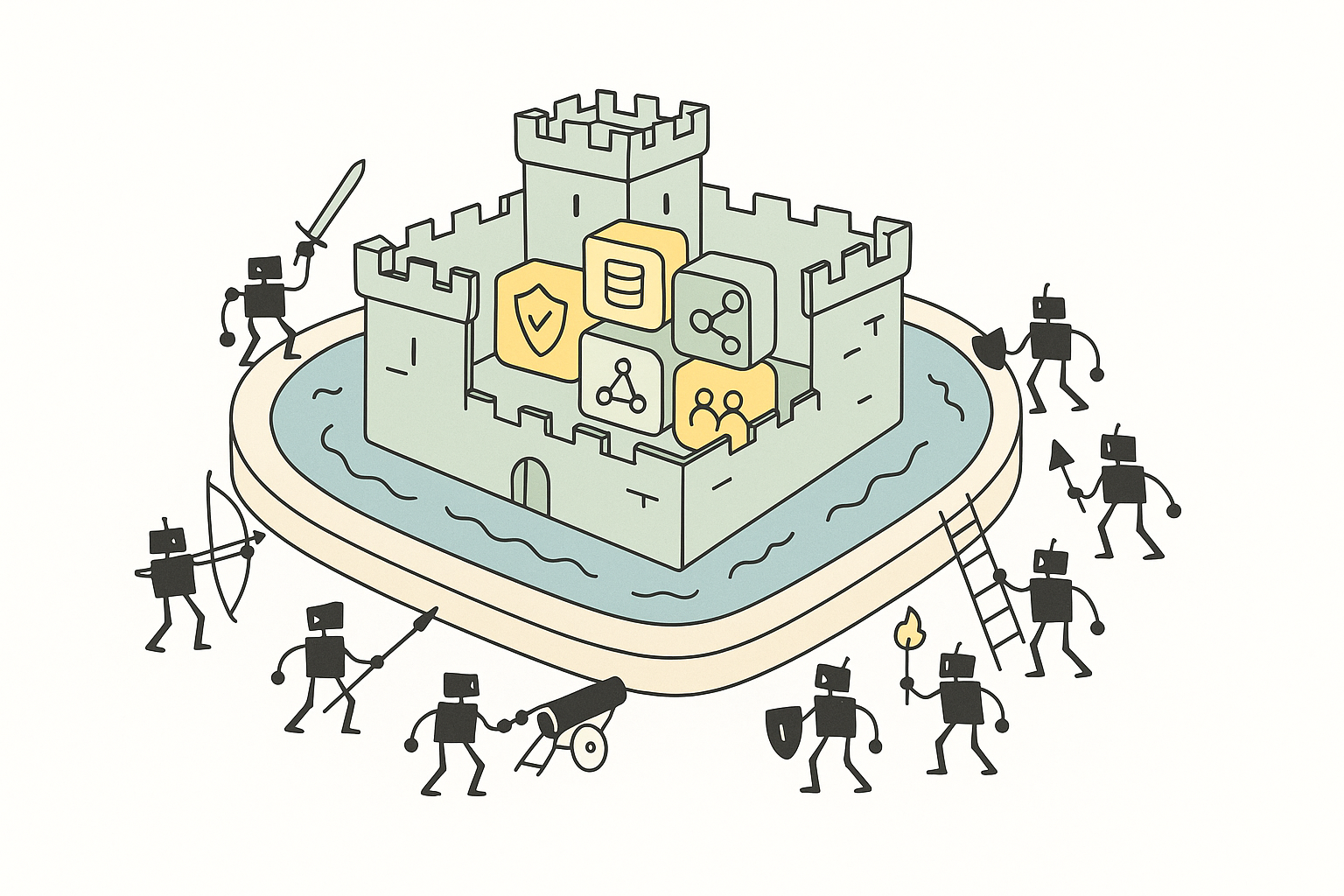AI Moats: How to Build a Defensible GTM Strategy in 2026

The GTM Operator’s Guide to AI Moats
AI pressure-tests every GTM move. Only structural moats (trust, data, distribution, system design, and community) stand up to the siege.
The Real Test of Defensibility in 2026
AI is ripping through weak advantages faster than anyone thought it would. I’ve seen teams spending weeks polishing a blog post and by the time it goes live, the feed is already full of AI-spun knockoffs. That clever ad line you were proud of? Tomorrow it’s running in a competitor’s carousel too. Even demos get stripped into templates that a half-decent SE with AI tools can spin into a pitch that looks just like yours or mine. If that’s the ground we’re standing on, it’s shaky…
What matters now is whether your GTM plan can hold up under that kind of pressure. Investors are asking harder questions about defensibility. They don’t care how many impressions you pulled last month if churn is climbing and CAC is creeping. Competitors are constantly probing, watching where your funnel breaks, and are ready to undercut the moment they see weakness. AI’s doing a brilliant job in expanding these cracks!
The only things that survive a siege are moats. Data loops that strengthen every time a customer interacts with the brand. Trust that moves deals forward because buyers believe you’ll deliver when everyone else looks the same in a search result. Distribution you own so you aren’t at the mercy of rented reach (i.e. social platforms like LinkedIn, FB, X) that can take away your years of hardwork with just one ‘wrong’ backend update. Systems and ops tight enough to outpace copycats. Communities that anchor belonging and make your product sticky. And culture… the invisible moat most leaders and companies ignore until they wonder why one team keeps shipping and performing while another can’t move past reorgs!
It’s easy to mistake traction for defensibility. A spike in SEO might look impressive but the rules of search are already being re-written by AI. Paid arbitrage fills the funnel until CAC balloons and the math collapses. Communities feel strong when the engagement is high… but without momentum, all you’re left with is a dead Slack channel. Those ‘wins’ were quick plays and temp lift, not moats. AI just makes the ground give way faster.
This is the real test of the new AI-first-GTM era. When AI tears through everything easy to copy, moats are what’s left standing, deep enough to resist the AI seige.
Data. Trust. Distribution. Systems. Communities. Culture. These are the defenses that buy you time, hold competitors back, and give you space to build forward.
So let’s start with data. Because if your data moat is weak, every other defense you rely on is already weaker.
Moat 1: Data
Every serious conversation about moats starts here. If your data is weak, every other layer you build on top crumbles faster. Competitors who see signals before you will move first. Investors sizing up your defensibility expect proof you own something unique, not access to dashboards they can buy too.
A common misstep is assuming a CRM or a purchased intent feed qualifies as a moat. Those tools are baseline. They keep the lights on, but they don’t create distance. AI only accelerates the collapse of that illusion because anything generic can be scraped, recombined, and resold.
The data that holds power is the kind that compounds. Each new customer makes the next interaction sharper. Each behavior adds context. Loops tighten over time until the gap is too wide for a new entrant to close.
Netflix built that flywheel. Competitors licensed shows too. The difference came from how Netflix tracked behavior across billions of sessions—what people finished, where they stopped, what they binged in a weekend. That feedback loop trained recommendations and hardened the moat with every click. Netflix’s recommendation research shows how deeply it runs.
Tesla took the same path on the road. Every braking event, lane change, or weather condition fed into the model. Updates went back to the fleet, making every car smarter. A rival can ship sensors and hire talent, but without the billions of miles logged, the refinement gap keeps widening. Tesla’s Autopilot learning system shows the compounding effect.
Stripe turned fraud into a moat. Each flagged transaction strengthened detection for the entire network. A small processor can copy rules, but they can’t match the real-time dataset Stripe processes across millions of businesses. That compounding loop is why Stripe Radar stays ahead.
Snowflake used sharing as the edge. Once enterprises began exchanging live data on its platform, the switching cost skyrocketed. The moat wasn’t storage—it was the network effect created by governed pipelines. Snowflake’s Data Cloud explains how that network locked in.
HubSpot leaned on telemetry. By watching adoption patterns across thousands of SMBs, HubSpot refined onboarding, tuned automation defaults, and built benchmarks others couldn’t replicate. Competitors could mimic features, but they didn’t have adoption insight at scale. HubSpot’s usage reports illustrate how the loop works.
How to test your own setup
- If third-party feeds were cut off tomorrow, would you still see signals flow?
- Does every new customer make your dataset more valuable for the next one?
- Could a fast follower replicate your view in six months with scraping tools?
- Are the signals changing how you target, price, or build products in real time?
What strong data looks like
- Proprietary, gathered through your own product or interactions.
- Behavioral, showing what people actually do instead of what they claim.
- Continuous, enriched by fresh cycles, not frozen in dashboards.
- Actionable, directly tied to decisions that move revenue.
Practical plays to start compounding
- Track product usage at a granular level—role, segment, workflow.
- Feed churn and expansion data back into scoring models every week.
- Tie feature adoption to revenue lift so you know which features matter.
- Publish anonymized benchmarks no one else can.
- Run weekly signal reviews so the loop stays alive between quarters.
Traps to avoid
- Treating rented data as an edge. Intent feeds lose value once everyone can buy the same ones.
- Performing dashboard theater. Pretty charts don’t matter if the numbers don’t move money.
- Hoarding feeds without cleanup. Ten noisy streams are worse than one clean one.
Why this moat matters most
Every other moat leans on this one.
Trust collapses without data behind it. Distribution burns cash if signals are vague. Systems optimize junk when inputs are wrong. Communities drift without feedback. Even culture erodes when teams lack shared facts.
Here’s the final gut check!
If a competitor cloned your campaigns tomorrow, would your data still give you an edge they can’t erase in a week?
If the answer feels shaky, that’s where you to focus.
CONTINUE THE SERIES
Moat 2: Trust
When every competitor claims credibility, buyers look for proof that can’t be faked. Let's see how companies turn transparency, evidence, and consistency into a moat that closes deals faster.


Jahnavi Ray is a data obsessed marketing leader with 17+ years of experience driving demand, building GTM engines, and mentoring growth-stage B2B teams. She’s led marketing inside startups, scaled systems at global SaaS companies, and now shares her playbooks to help founders and marketers turn chaos into clarity, and pipeline into predictable revenue. When she’s not mapping growth ecosystems or coaching on GrowthMentor, you’ll find her practicing yoga, chasing her two gremlins, or building something meaningful in Toronto.